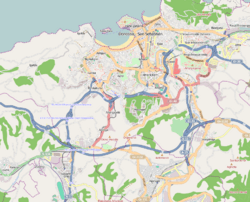San Sebastián facts for kids
Quick facts for kids
San Sebastián
|
|||
|---|---|---|---|
| Donostia / San Sebastián | |||

San Sebastián and Kontxa bay from Igeldo mountain
|
|||
|
|||
| Motto(s): | |||
| Country | |||
| Autonomous community | |||
| Province | Gipuzkoa | ||
| Comarca | Donostialdea | ||
| Neighbourhoods | 21 | ||
| Founded | 1180 | ||
| Area | |||
| • Land | 60.89 km2 (23.51 sq mi) | ||
| Elevation | 6 m (20 ft) | ||
| Population
(2011)
|
|||
| • Total | 186,409 | ||
| • Density | 3,686.16/km2 (9,547.1/sq mi) | ||
| Time zone | UTC+1 (CET) | ||
| • Summer (DST) | UTC+2 (CEST) | ||
| Postal code |
20001-20018
|
||
| Area code(s) | 34 + 943 (Gipuzkoa) | ||
| Website | City Council | ||
San Sebastián is a beautiful coastal city in the Basque Country, Spain. It sits right on the Bay of Biscay coast. This city is also the capital of a region called Gipuzkoa.
San Sebastián is only about 20 kilometers (12 miles) from the French border. In 2012, about 186,409 people lived there. People from San Sebastián are called donostiarra (doh-noh-stee-AH-rrah) in both Spanish and Basque.
Contents
Exploring San Sebastián's Location
San Sebastián is in the northern part of the Basque Autonomous Community. It's known for its stunning location on the southern coast of the Bay of Biscay.
Beaches and Mountains
The city is famous for its three amazing beaches: Concha, Ondarreta, and Zurriola. These beaches make it a very popular place for tourists to visit.
San Sebastián is also surrounded by hills and mountains that are easy to explore. These include:
- Urgull mountain, right next to the old part of the city.
- Mount Ulia, which stretches east towards a town called Pasaia.
- Mount Adarra, located south of the city.
- Igeldo mountain, which offers a great view over Concha Bay from the west.
The Urumea River
The city is built at the mouth of the Urumea River. Over the last two centuries, a lot of San Sebastián has been built on what used to be the river's wetlands.
For example, the city center and areas like Amara Berri and Riberas de Loiola are on the old riverbed. The river was moved into a special canal in the early 1900s to make way for the city's growth.
Weather in San Sebastián
San Sebastián has an oceanic climate, which means it has warm summers and cool winters. This type of climate often brings cloudy or overcast days for much of the year, usually with some rain.
Rainfall and Sunshine
The city gets about 1,650 millimeters (65 inches) of rain each year. This rain is spread out fairly evenly throughout the year. However, the summer months are a bit drier and much sunnier. During summer, San Sebastián gets about 100 millimeters (4 inches) of rain on average.
Temperatures Throughout the Year
The average temperatures in San Sebastián change with the seasons:
- In January, the average temperature is about 8.9°C (48.0°F).
- In August, which is the warmest month, the average temperature is around 21.5°C (70.7°F).
Images for kids
-
British siege of San Sebastián in 1813
-
Santa Catalina Bridge after erection of the Maria Cristina Bridge (1905–1910)
-
Kursaal Palace and Kursaal Bridge at night
-
Zurriola Bridge and mouth of the Urumea
-
Jamón serrano and pintxos in one of the numerous bars of the Old Quarter
-
The comb of the wind: Peine del viento/Haizearen orrazia sculptures of Eduardo Chillida at the foot of the Igeldo mountain
See also
 In Spanish: San Sebastián para niños
In Spanish: San Sebastián para niños
































